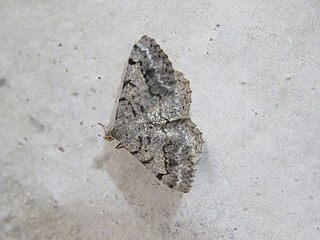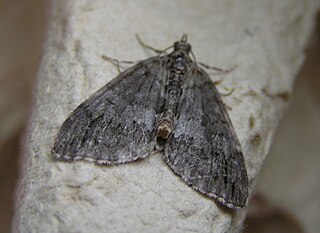| Nephelodes | |
|---|---|
 | |
| Nephelodes minians | |
| Scientific classification | |
| Domain: | Eukaryota |
| Kingdom: | Animalia |
| Phylum: | Arthropoda |
| Class: | Insecta |
| Order: | Lepidoptera |
| Superfamily: | Noctuoidea |
| Family: | Noctuidae |
| Tribe: | Tholerini |
| Genus: | Nephelodes Guenée, 1852 |
| Nephelodes | |
|---|---|
 | |
| Nephelodes minians | |
| Scientific classification | |
| Domain: | Eukaryota |
| Kingdom: | Animalia |
| Phylum: | Arthropoda |
| Class: | Insecta |
| Order: | Lepidoptera |
| Superfamily: | Noctuoidea |
| Family: | Noctuidae |
| Tribe: | Tholerini |
| Genus: | Nephelodes Guenée, 1852 |
Symphyta is a genus of moths in the family Lasiocampidae. The genus was erected by Turner in 1902. All species were described from Australia.

Xestia is a genus of noctuid moths. They are the type genus of the tribe Xestiini in subfamily Noctuinae, though some authors merge this tribe with the Noctuini. Species in this genus are commonly known as "clays", "darts" or "rustics", but such names are commonplace among Noctuidae. Xestia moths have a wide distribution, though they most prominently occur in the Holarctic.

Cisthene is a genus of lichen moths in the family Erebidae. The genus was erected by Francis Walker in 1854.

Euchaetes is a genus of moths in the family Erebidae. It was described by Thaddeus William Harris in 1841.

Frederickia is a genus of moths in the family Geometridae described by Alexander Douglas Campbell Ferguson in 2008.

Idia is a genus of litter moths of the family Erebidae first described by Jacob Hübner in 1813.

Cryphia is a genus of moths of the family Noctuidae. The genus was erected by Jacob Hübner in 1818.

Euxoa is a genus of moths of the family Noctuidae raised to Genus by the German entomologist, Jacob Hübner. The Genus is mostly confined to dry and semi dry areas in the Northern Hemisphere. There 130 species in Eurasia, a few in Africa, and 175 in North America. There are no species in the Genus in South-East Asia or in Australia. In North America, most species are found in Western regions. Of the North American species, 4 are endemic to Mexico. There is one species recorded from Chile, but this may be a mislabeled specimen. In real terms, species numbers do not equal species abundance. Some areas with few species have large numbers of the ones that do live there.

Plagiomimicus is a genus of moths of the family Noctuidae. The genus was erected by Augustus Radcliffe Grote in 1873.

Nephelodes minians, the bronzed cutworm or shaded umber moth, is a moth of the family Noctuidae. It is found in most of North America, except Florida and adjacent states.

Hydriomena is a genus of moths in the family Geometridae described by Jacob Hübner in 1825.
Hyposmocoma nephelodes is a species of moth of the family Cosmopterigidae. It was first described by Lord Walsingham in 1907. It is endemic to the Hawaiian island of Oahu and possibly Maui. The type locality is the Waianae Range.

Hellinsia is a genus of moths in the family Pterophoridae. It was created by J.W. Tutt in honour of the entomologist John Hellins.

Epicephala is a genus of moths in the family Gracillariidae.
Epicephala nephelodes is a moth of the family Gracillariidae. It is known from Queensland, Australia.
Saphenista nephelodes is a species of moth of the family Tortricidae. It is found in Bolivia.

Salma is a genus of snout moths. It was described by Francis Walker in 1863.
Nephelodes demaculata is a species of cutworm or dart moth in the family Noctuidae first described by William Barnes and James Halliday McDunnough in 1918. It is found in North America.
Nephelodes carminata is a species of cutworm or dart moth in the family Noctuidae. It is found in North America.

Mastophora hutchinsoni, also known as the American bolas spider, is a species of orb weaver in the genus Mastophora. The genus is distributed extensively throughout various subtropical geographical areas including Australia, South Africa, Oriental Asia, and the Americas and is not found in Europe. The hunting behavior of adult female M. hutchinsoni is unusual because they are bolas spiders. They mimic moth pheromones to attract male moths, and female M. hutchinsoni have evolved to alter their chemical release to target different moths. They then capture their prey with a sticky drop on the end of a silk line, resembling a bolas.